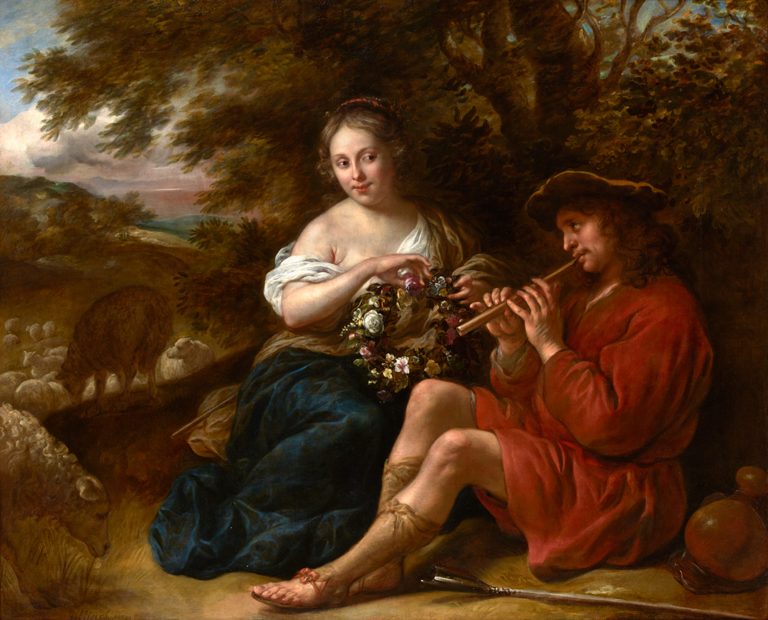Govaert Flinck’s depiction of an amorous shepherd and shepherdess in the warm, evening light of a rolling landscape captures the lyrical character of the Dutch pastoral tradition.1 The shepherd, dressed in a burnt umber robe, calf-high sandals, and a floppy brown hat, plays a recorder as he gazes longingly at the shepherdess seated beside him.2 She returns her lover’s gaze with a coy, sideways glance, while placing a rose on her garland of flowers. Her arm barely conceals the plunging neckline of her bodice, which she wears over a voluminous, blue satin skirt. A lamb grazes near the pair’s feet, while the rest of the flock is visible beyond the shady enclosure of the trees.
The Leiden Collection painting is the only multi-figure pastoral landscape that Flinck executed during his career, and it reflects his familiarity with a broader pastoral tradition in the Netherlands. While Pieter Lastman (1583–1633) was the first to depict pastoral scenes, in Amsterdam in the 1610s, the genre most fully developed in Utrecht in the 1620s.3 There, Abraham Bloemaert (1566–1651), Paulus Moreelse (1571–1638), and Gerrit van Honthorst (1592–1656) began to produce half-length representations of shepherds and shepherdesses, popularizing the convention for pastoral images that quickly spread to cities such as Amsterdam and Dordrecht.4 Flinck’s own interest in pastoral subject matter began in the mid-1630s in the Amsterdam workshop of Rembrandt van Rijn (1606–69), evident in his portraits of Rembrandt and Saskia as Shepherd (fig 1) and Shepherdess from 1636.5 In the Leiden Collection work, Flinck more directly explored the Arcadian themes of love and music by depicting the figures in the acts of flute playing and garland making, roles that were traditionally associated with shepherds and shepherdesses.6
The Dutch interest in the portrayal of pastoral figures grew from a literary tradition that espoused the values of the simple, idyllic life of the shepherd. Works such as Pieter Cornelisz Hooft’s Granida, published in 1615, and Johan van Heemskerck’s Batavische Arcadia, from 1637, which were inspired by antique and Italian precedents, spurred the growing taste for pastoral cultural ideals.7 The flowering of this genre was similarly evident in the production of Crispijn de Passe’s book of engraved pastoral portraits, Les vrais portraits de quelques unes des plus grandes dames de la Chrestiente, desguisées en bergères, from 1640, as well as in the Hofdicht, or “country house” poetry and songbooks, of Jacob Cats, Jan Harmens Krul, and Joost van den Vondel, which were published in Amsterdam in the middle decades of the century.8
A number of Dutch artists in this period portrayed the interaction between an amorous shepherd and shepherdess in a landscape, largely without a specific narrative.9 In his Pastoral Scene of 1627 (fig 2), for example, Abraham Bloemaert focused on the relationship between the shepherd and shepherdess in an expansive landscape.10 The shepherdess, identified by her crook and gourd, engages the advances of the humble shepherd who brazenly places his flute under her skirt. This sense of amorous revelry resonates in Flinck’s painting, although the relationship between the figures is more convincingly portrayed as one of reciprocal pastoral love. With her ivory skin, blond hair, and revealing neckline, Flinck’s elegant shepherdess welcomes the flirtatious advances of her male companion. Flinck emphasized the sensuous nature of their interchange by positioning the woman’s circular garland directly at the end of the shepherd’s flute.11 The soft, graceful forms of Flinck’s figures and the earth-toned palette reflect the lyricism of the pastoral tradition and the evocation of Arcadian themes.12
The subject and character of the Leiden Collection painting are also consistent with the broader classicizing interests and style of history painters working in Amsterdam around 1650.13 Artists such as Jacob Backer (1608/9–51), Ferdinand Bol (1616–80), Jacob van Loo (1614–70), and Gerbrand van den Eeckhout (1621–74), turned increasingly to subjects drawn from or inspired by Dutch and Italian pastoral literature and mythology.14 For example, in Bol’s Portrait of Leonard Winnincx and Helena van den Heuvel as Jason and Medea (fig 3), from 1664, the couple’s exchange similarly occurs in the foreground beneath a dense cluster of trees.15 Although the eroticism of Bol’s image is made more explicit by the woman’s exposed breast, the large, solid figures and warm palette suggest the commonalities between Flinck and Bol’s compositional and stylistic approaches. Flinck’s broad, sweeping brushstrokes and looser handling of paint, however, distinguish this work from that of his contemporary and enhance its suggestive and elegant tone. These qualities would have made the Leiden Collection painting suitable as a chimneypiece in a sophisticated Amsterdam home, a setting that reflected the elite, intellectual circles in which Flinck operated in the seventeenth century.16
